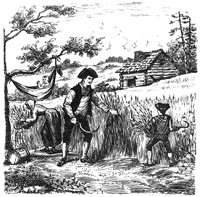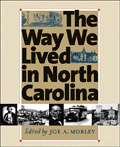
Harvesting wheat.
|



OVERVIEW . . .
CHAPTER EXCERPTS
 n 1770 North Carolina sheltered a remarkable human diversity. Parts of the Albemarle Sound region had been settled by the English for more than a century. There and along the lower reaches of the Cape Fear River wealthy farmers and their African American slaves had laid the basis for a plantation society. In the western mountains, Cherokee Indians continued their traditional ways of life with little or no interference from distant whites. In between, English, Scotch-Irish, German, and Highland Scottish settlers carved out new homes in the dense forest. The inhabitants of the largest towns differed markedly from their rural neighbors in their work, their social position, and their personal opportunity. The people of North Carolina were not clearly united in politics, language, religion, or any other cultural characteristics. In many ways it would be difficult to think of them as members of the same society. n 1770 North Carolina sheltered a remarkable human diversity. Parts of the Albemarle Sound region had been settled by the English for more than a century. There and along the lower reaches of the Cape Fear River wealthy farmers and their African American slaves had laid the basis for a plantation society. In the western mountains, Cherokee Indians continued their traditional ways of life with little or no interference from distant whites. In between, English, Scotch-Irish, German, and Highland Scottish settlers carved out new homes in the dense forest. The inhabitants of the largest towns differed markedly from their rural neighbors in their work, their social position, and their personal opportunity. The people of North Carolina were not clearly united in politics, language, religion, or any other cultural characteristics. In many ways it would be difficult to think of them as members of the same society.
If North Carolinians shared any characteristic besides diversity, it was their basic reliance on the outside world for a variety of cultural and commercial necessities. For the most part, Carolinians supplied themselves with the corn, meat, shelter, and clothing that were necessary for simple survival, but their self-sufficiency was more a condition of wilderness isolation than true independence. Sophisticated products and ideas almost always came from elsewhere. Iron, salt, and rum came from the schooners that docked at New Bern, Edenton, and Wilmington. Fashions, furniture, and elaborate building designs came from sketches published in Europe. Religious authority came from clergymen born and trained abroad, and governmental power came from Great Britain in the person of a royal governor.

As they moved through half a century of social and political change, North Carolinians left signs of their steady transformation in the buildings and other material products of their culture. Log cabins gave way to frame cottages, and changing private homes revealed a shift in ideal family arrangements. Architectural fashions from distant capitals translated themselves into appropriate forms for Carolina farmhouses. Cultural monuments like schools, churches, and public buildings displayed the tastes and ideals of an independent people.
Changes in politics, economics, religion, and ideology had an impact on Carolina lifestyles, just as the daily lives of the people exerted a pervasive pressure on the direction of larger historical events. Visitors to North Carolina's historic sites can witness the history of an era as they follow the physical evolution of the way we lived in the years that saw the establishment and early growth of the American republic.
|

